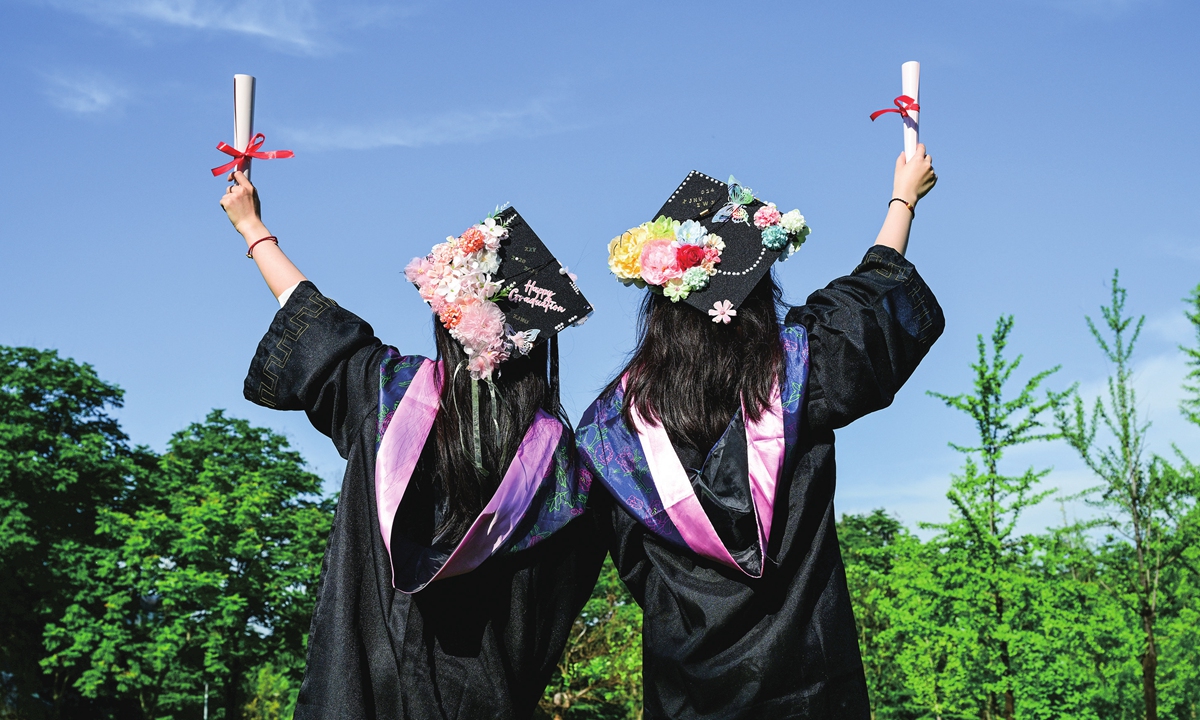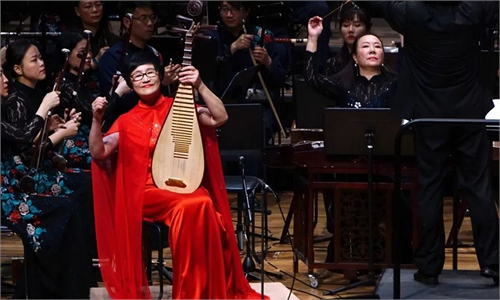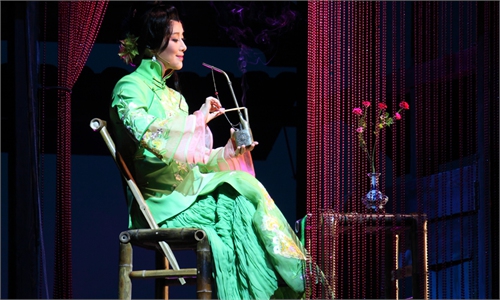ARTS / CULTURE & LEISURE
Chinese-style photos sweep across campus graduation season
From uniformity to diversity

Students show off their customized Chinese-style graduation caps. Photo: VCG
A few days ago, Ran Yulu, a master's graduate from Chongqing University's Class of 2025 stood in front of the dormitory mirror, carefully adjusting the pleats of her Mamian skirt, feeling both nervous and excited — she was preparing for a special graduation photo shoot.
"I used to think Mamian skirts only belonged to ancient times. But now, seeing them appear in our graduation photos is not just about tradition, it's a new encounter between the younger generation and our cultural heritage," she told the Global Times.
Ran recalled that she and her classmates posed for a series of graduation photos across the campus, capturing moments by the stone steps, in front of the library, and under the university's iconic gates, this time, with traditional Chinese elements woven into their attire.
Unlike previous years, when graduation photos were mostly dominated by academic gowns, today's Chinese university students are opting for a more diverse range of styles. Many are incorporating elements of traditional culture into their graduation outfits, creating unique "yearbooks of youth," according to People's Daily.
Diverse expressions
According to Ran, it wasn't long ago that graduation photos all looked similar — rows of students dressed in identical academic gowns. "It looked formal, sure, but also a bit monotonous," she recalled.
"Now, people are wearing hanfu, Mamian skirts, or adding traditional touches to their outfits. The photos feel unique and much more memorable," Ran said. "When we look back, years from now, those pictures will remind us not only of our youth, but also of the cultural identity we carried with us."
Like Ran, Liu Xinchen, a master's graduate from Fudan University's Class of 2024, and now a teacher at a secondary school in Beijing, told the Global Times that although she graduated last year, seeing the new wave of Chinese-style graduation photos fills her with pride.
"In the past, only a handful of students experimented with traditional clothing for graduation photos. But these two years, many of my classmates are choosing traditional Chinese elements, some even taking family portraits in full hanfu," she said. "More and more students are willing to bring traditional culture into daily life, graduation photos are just the beginning."
In Liu's view, this isn't simply about chasing trends, it reflects a deeper cultural confidence among young people.
"Graduation is a milestone moment in life. Everyone wants the memory to be special, to say something about who we are. For many of us, embracing traditional culture is part of that identity," she explained. "Taking Chinese-style graduation photos is just the beginning. More people are willing to bring traditional culture into daily life."
On social media, alongside Chinese students sharing their Chinese-style graduation portraits, sometimes taken with their partners graduating in the same year, there has also been a growing number of graduates posing for photos with their parents. A small group of Chinese students studying overseas have also embraced the trend, choosing to experience these uniquely Chinese-style graduation photos, according to Red Star News.
Behind the camera
Behind this shift lies a tangible market trend. According to China News Service, searches for yunjian (a traditional shoulder accessory), have more than doubled during this year's graduation season, with Mamian skirts, qipao (a close-fitting woman's dress with high neck and slit skirt), and floral hair ornaments also seeing significant growth in popularity.
To meet the rising demand for personalized graduation styles, photography studios across the country have launched a range of tailored services, including "campus photo walks," academic gown portraits, and Chinese-themed graduation shoots featuring yunjian and floral accessories. These packages typically offer full styling, outfit rentals, professional photography, and post-editing, according to China News Service.
"The number of Chinese-style graduation photo orders has increased significantly over the past two years," Zhao Yafeng, a freelance photographer based in Beijing, told the Global Times.
In the past, most of her graduation shoots focused on standard academic gowns and formal portraits. But this year, Chinese-style graduation photos have emerged as the most popular choice.
"It's not just the girls in Mamian skirts or qipao anymore," Zhao said. "More and more male students are embracing traditional styles, experimenting with modernized hanfu, round-collar garments, and even creative outfits infused with regional cultural elements."
Zhao has observed that Chinese-style graduation photos are no longer simply about capturing an image, they reflect a broader shift in young people's approach to cultural consumption.
"Students aren't satisfied with just taking a few standard photos anymore. They're willing to invest more, to tell a personal story through the pictures, even to showcase pride in their hometowns," Zhao said.
"Many students now design their own accessories or customize traditional outfits, while photography teams study the cultural history behind the clothing and carefully plan lighting and styling," she said. "The entire process has evolved into an immersive cultural experience."
Wang Deyan, a cultural studies professor at North China University of Technology, believes the popularity of Chinese-style graduation photos is a vivid reflection of China's growing cultural soft power.
"Young people no longer see traditional culture as a distant, untouchable symbol, they are weaving it into daily life and life's milestones," Wang told the Global Times. "This is cultural confidence made tangible in people's lives, it reflects the subtle yet profound ways contemporary Chinese culture is being expressed."
According to Wang, for these graduates, leaving campus marks the end of one chapter. But the images they've captured, infused with tradition and cultural meaning, will accompany them as they embark on new journeys in life.



